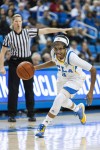This article was updated on March 9 at 2:34 a.m.
Five months, 30 games and more than 1,239 minutes.
It all came down to one split-second play near half-court when the ball hovered in the air before descending upon two hands, both battling for possession.
The call on that loose ball was the difference between UCLA getting a last-second chance to topple Stanford or needing to foul the Cardinal to stay in the game.
After a battle that came down to the final eight seconds, No. 6-seeded UCLA fell victim to No. 3-seeded Stanford, 67-62, and missed a chance to reach the semifinal of the Pac-12 tournament as well as a run to the 64-team NCAA tournament.
“It’s hard, because moral victories don’t feel as good as actual victories,” said coach Cori Close. “As a coach, you want your team to have zero regrets in the way they believed in each other, the kind of teammates they were, how mentally focused they were. I just couldn’t be any more proud of those things.”
Despite the loss, the Bruins didn’t let the Cardinal advance in the tournament without first breaking a sweat.
Although Stanford was able to utilize its screens more effectively and gain a 12-point lead with a 1:30 left in the first half, UCLA fired on all cylinders to construct a 7-0 run in the final 90 seconds of the period.
“We had urgency,” said redshirt sophomore guard Kari Korver, whose shot clock buzzer-beater jumper capped the run. “We knew that we needed to cut the lead down heading into halftime and quick lapses on (Stanford’s) part allowed us to score.”
Out of the break, a gust of momentum filled the Cardinal’s sails as its five-point halftime lead swelled into another 12-point advantage. However, UCLA was able to tie the game with under five minutes to go after finding key holes in the Stanford defense, forcing fouls and rebounding the ball effectively.
But after UCLA tied it, Stanford didn’t allow the Bruins to take a lead.
With 20 seconds left, and the Bruins down by a point, a lengthy official review would play a critical role in the outcome of the game. The officials reviewed whether or not the ball last touched UCLA junior guard Nirra Fields or Stanford guard Amber Orrange before soaring out of bounds. In the end, the call went Stanford’s way.
The Bruins, down by three, watched the final eight seconds expire after a 3-point attempt by redshirt freshman forward Paulina Hersler failed to reach its target.
Though the game ended unfavorably on the scoreboard for UCLA, the team was able to pull off key elements of its game plan.
The Bruins were able to provide enough pressure on defense to prevent Stanford from firing a stream of 3-pointers. Forward Bonnie Samuelson, who scored eight 3-pointers against the Bruins on Feb. 15, was only allowed one successful shot from beyond the arc on Friday.
Korver said that the Bruins changed their entire defensive strategy for Stanford, adjusting their focal point to limiting Samuelson’s touches.
“On every screen that (Samuelson) set her team off of, we were stuck to her like glue,” Korver said. “Maybe we gave up more layups because of the way we played screens, but we didn’t give up as many 3-pointers. That is what made it a closer game.”
Solid rebounding efforts were an additional aspect of the Bruins’ game plan that came into fruition on Friday, largely accounting for the second-half comeback. UCLA dominated Stanford on the boards, 48-34, and more than doubled the Cardinals’ offensive rebound total.
Redshirt junior forward Kacy Swain took charge for the Bruins under the rim with 11 rebounds. Although she was 0-8 from the field in the first half, Swain was able to record a double-double by the final buzzer.
Pac-12 Freshman of the Year, guard Jordin Canada, led the Bruins with 15 points and eight assists. Korver tallied 12 points. Senior forward/center Corinne Costa grabbed seven rebounds.
The disparities in age and experience meshed together Friday. There was visible effort not dominated by just the veterans, but also by the youth who had matured into the roles the team needed them to fill.
While the stat sheets typified the Bruins’ growth in numbers, Close saw the growth primarily in something impossible to measure with digits: character improvement.
“Caring for each other as a good teammate, the growth, the mental focus – those things that are on the inside will follow these ladies way past when the basketball goes flat,” Close said.
After facing the nation’s toughest preseason schedule and dropping 11 games to ranked opponents, the Bruins knew that the experience of playing at that level would eventually reap dividends.
“It started from preseason, playing against teams like Stanford,” Canada said. “We’ve been down for a majority of games playing against teams like that, and we continued to stay together. Tonight that really showed … we’ve battled back.”
Korver, too, saw a year’s worth of diligence pay off, even without a Pac-12 tournament trophy.
“We were expecting to have more success (at the start of the season), but we hit adversity,” she said. “I think we learned a lot from it. Today was the best game we’ve played all year. … The best 40 minutes.”
